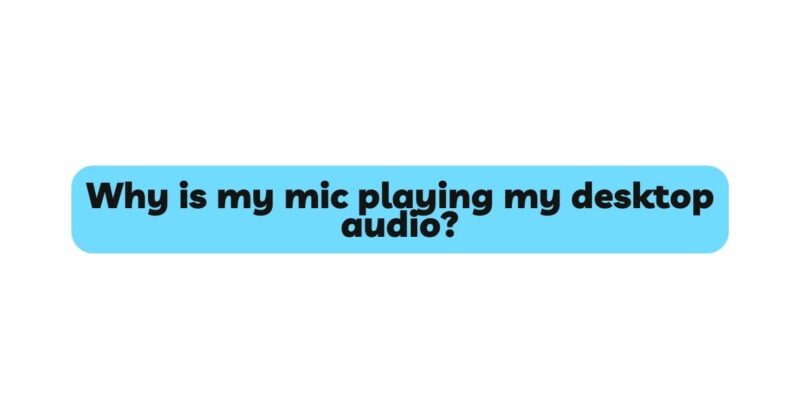In the realm of modern digital communication and content creation, microphones have emerged as indispensable tools for transmitting clear and impactful audio. Yet, a common and frustrating issue faced by many individuals is the occurrence of their microphones playing back desktop audio. This bewildering occurrence, where sounds from the computer, such as system alerts, music, and application noises, are heard through the microphone, can significantly hamper the quality of recordings and communication. This article delves into the underlying reasons behind this phenomenon and provides comprehensive strategies to effectively resolve the problem of desktop audio playback through your microphone.
1. Understanding Audio Loopback
The phenomenon of your microphone picking up and playing back desktop audio is often referred to as “audio loopback” or “feedback loop.” This occurs when the output audio from your computer is routed back into the microphone, creating a continuous cycle of sound. Essentially, the microphone captures the audio output from the computer’s speakers, which is then relayed back through the microphone, leading to an endless loop of sound playback.
2. Microphone Sensitivity and Design
Microphone sensitivity, a key attribute of microphones, plays a pivotal role in the occurrence of audio loopback. Microphones with higher sensitivity, such as condenser microphones, are more likely to pick up background sounds, including the computer’s audio output. This heightened sensitivity, while advantageous for capturing nuances in speech and music, can inadvertently lead to the microphone picking up desktop audio.
3. Acoustic Environment and Sound Reflections
The acoustics of your recording environment can contribute to the occurrence of desktop audio playback. Rooms with hard surfaces, like walls, floors, and furniture, can cause sound waves to bounce and reflect. These reflections can direct the computer’s audio output toward the microphone, initiating the loopback effect. Soundproofing measures and strategic placement of sound-absorbing materials can minimize these reflections and reduce the chances of audio loopback.
4. Microphone Placement and Directionality
The positioning of your microphone relative to the computer and speakers is another significant factor in audio loopback. If your microphone is situated too close to the computer’s speakers, it can inadvertently capture the output audio and initiate the feedback loop. Choosing a microphone with a directional pickup pattern, such as cardioid, can help mitigate the issue by focusing on sounds directly in front of the microphone while rejecting sounds from other directions.
5. Output and Input Audio Settings
The audio settings on your computer play a pivotal role in determining whether audio loopback occurs. If the output audio settings are set to play through both the computer’s speakers and the microphone, it can create a feedback loop. Ensuring that your output audio is not routed to the microphone input is essential to prevent audio loopback.
6. Software and Applications
Certain software applications and communication platforms may inadvertently contribute to audio loopback. Video conferencing applications, for instance, may have settings that allow audio from the microphone to be played back through the speakers, inadvertently causing loopback. Reviewing and adjusting the settings within these applications can resolve this issue.
7. Audio Drivers and System Settings
Outdated or improperly configured audio drivers can also contribute to audio loopback. Ensuring that your audio drivers are up to date and correctly configured is essential. Additionally, checking system settings related to audio playback and input can help identify and rectify potential loopback sources.
8. Noise Cancellation and Echo Suppression
Some audio processing features, such as noise cancellation and echo suppression, can inadvertently contribute to audio loopback. While these features are designed to enhance audio quality during communication, they may inadvertently create a feedback loop if not properly configured. Adjusting these settings to strike the right balance between audio enhancement and loopback prevention is crucial.
9. Hardware Solutions
In some cases, employing hardware solutions can effectively address audio loopback. Using headphones instead of speakers can prevent output audio from being captured by the microphone. Additionally, utilizing a physical barrier, such as a foam shield or isolation mount, between the microphone and the computer’s audio source can reduce the likelihood of loopback.
Conclusion
The mystery of your microphone playing back desktop audio is illuminated when considering the intricacies of microphone sensitivity, acoustic environments, microphone placement, audio settings, and software factors. By comprehending the root causes and adopting strategic measures, you can effectively resolve the issue of audio loopback. This ensures that your recordings, communication, and content creation endeavors are characterized by pristine and uninterrupted audio quality. As technology evolves and communication methods diversify, the ability to navigate and troubleshoot such challenges becomes an essential skill, empowering you to harness the full potential of your microphone and deliver exceptional audio experiences.


